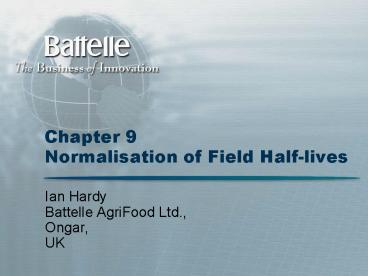Chapter 9 Normalisation of Field Half-lives - PowerPoint PPT Presentation
1 / 28
Title:
Chapter 9 Normalisation of Field Half-lives
Description:
Daily meteorological data should be available (rainfall, air temperatures etc. ... are available for calculating soil temperatures from min/max air temperatures ... – PowerPoint PPT presentation
Number of Views:17
Avg rating:3.0/5.0
Title: Chapter 9 Normalisation of Field Half-lives
1
Chapter 9Normalisation of Field Half-lives
- Ian HardyBattelle AgriFood Ltd.,Ongar,UK
2
Overview
- Overview / Basic Processes
- Availability of data for soil temperature and
moisture content - Approaches to normalisation
- Average temperature and moisture content
- Time-step normalisation
- Rate constant optimisation
- Conclusions
3
Overview
- Why do we want to normalise field data ?
- Degradation is investigated under more realistic
use conditions for the product - Enables use in risk assessments e.g. FOCUS
groundwater models - Large amounts of useful information are generated
during the field studies which are not fully
utilised in evaluations
4
Assessment of Study Design and Results
- A preliminary check of the field study should be
made to assess the suitability for its use in
normalisation procedures - Assess the significance of dissipation processes
such as photodegradation and volatilisation. If
they are unimportant, or can be properly
addressed during the evaluation, then the use of
the data in normalisation procedures is possible - The soil should be well characterised at
different depths - The sampling depth and analytical method should
allow for the bulk of the applied material to be
evaluated - Daily meteorological data should be available
(rainfall, air temperatures etc.) - Cropping and pesticide use history
5
Basic Processes
- Normalisation techniques should be consistent
with the process implementation in the subsequent
model used for risk assessment - For temperature Standard FOCUS Q10 (2.2) or
Arrhenius approaches can be used - For moisture Walker B-factor (0.7) approach
typically used - Can normalise to any reference conditionse.g.
20oC/pF2 for EU or 25oC/75 pF2.5 for US
6
Data Availability
- What data should we use for normalisation ?
- Field half-lives are normalised to reference
conditions reflecting the major influence factors
on field dissipation soil temperature and soil
moisture - The normalisation is conducted using daily
measured or simulated values for soil temperature
and moisture - A number of algorithms are available for
calculating soil temperatures from min/max air
temperatures - Soil moisture can be readily estimated using the
FOCUS groundwater models
7
Soil Temperature Estimation
8
Approaches to Normalisation
- Three approaches considered
- Average soil temperature and moisture content
- Time-step normalisation
- Rate constant optimisation
9
Average Temperature and Moisture Content
- Good approximation for short-term kinetics when
the mean temperature is relatively stable - The average soil temperature and moisture content
are determined over an appropriate period and
normalisation conducted as for laboratory studies - Useful for older studies with limited measurement
data and can give comparable results to the more
complex methods - Not suitable for long periods e.g. over several
seasons where the conditions vary significantly
10
Average Temperature and Moisture Content
Appropriate over this period
Not appropriate over this period
11
Average Temperature and Moisture Content
- Advantages
- Good approximation for short-term kinetics
(i.e. over 1-month) where there is no big
variation in conditions - Easy to calculate
- Same methodology as for laboratory studies
- Disadvantages
- Not appropriate for long-term kinetics
12
Time-step Normalisation
- Concept
- Daily variation in soil temperature and moisture
content is accounted for using a normalised
day-length (NDL) approach - 1 day at 15oC and 80FC is equivalent to 0.58
days at 20oC and 100FC - 1 day at 25oC and 90FC is equivalent to 1.38
days at 20oC and 100FC - Cumulative NDL is then calculated between
sampling points - Standard kinetic tools used for evaluations
13
Time-step Normalisation
14
Time-step Normalisation
Data points regressed along the time axis
15
Time-step Normalisation
Plot cumulative NDL vs residue
16
Time-step Normalisation
17
Time-step Normalisation
- Real example
- 2 year field dissipation study conducted in
Northern Europe - Winter application
18
Time-step Normalisation
19
Time-step Normalisation
20
Time-step Normalisation
Site 1 Site 1
Sampling time (days) Timestep(days)
0 0.0
61 25.0
184 59.4
274 105.5
327 145.2
428 193.0
544 229.8
604 256.4
671 289.5
726 321.9
21
Time-step Normalisation
Normalised DT50 102 days Min ?2
6.0 Significant at gt99
22
Time-step Normalisation
- Advantages
- Easy to calculate daily factors from available
data - No restriction on time periods or parameter
variation (i.e. whole year / season can be
modelled) - Applies the correction to the whole dataset at
once - Standard kinetic modelling schemes and tools can
be used for the subsequent analysis of the data - Disadvantages
- Same correction factors (Q10, B) applied to whole
dataset although multiple regressions can be
made
23
Rate Constant Optimisation
- Uses the same assumptions and input data as the
timestep approach - The reference rate constant is adjusted on a
daily basis for soil temperature and moisture
content and fitted to the measured data
24
Rate Constant Optimisation
25
Rate Constant Optimisation
26
Rate constant optimisation
Normalised DT50 99 days Min ?2
5.8 Significant at gt99
27
Rate Constant Optimisation
- Advantages
- No restriction on time periods or parameter
variation (i.e. whole year / season can be
modelled) - Good visualisation of the effects of soil
temperature and moisture content on the dataset
and kinetics - Individual Q10 and B factors can be applied
- Disadvantages
- Requires higher level model to implement (e.g.
ModelMaker) - Sometimes difficult to optimise complicated
metabolite schemes
28
Conclusions
- A number of approaches can be used to robustly
derive normalised degradation rates from field
studies for use in risk assessments - The methodology can be used to evaluate data from
different seasons and application timings and to
understand the processes important for
degradation































